According to scientific theories, the existence of dinosaurs on Earth dates back millions of years. Throughout their reign, numerous species emerged and evolved, each with unique characteristics and abilities.
However, among this diverse group of ancient reptiles, one particular question continues to captivate researchers and dinosaur enthusiasts alike: which dinosaur was the most dangerous? In an attempt to shed light on this intriguing topic, this article explores ten formidable contenders for the title of the most dangerous dinosaur.
Ranging from Spinosaurus and Stegosaurus to Velociraptor and Acrocanthosaurus, these prehistoric creatures possess distinct traits that made them formidable predators in their respective ecosystems. By delving into their anatomical features, hunting strategies, and fossil evidence, we can gain a deeper understanding of the factors that contributed to their dominance in the prehistoric world.
Join us as we embark on a scientific journey into the past to explore the remarkable world of these ancient apex predators.
Key Takeaways
- The most dangerous dinosaur is the Tyrannosaurus rex, with its lethal bite force and deadly bacteria in its saliva.
- The Spinosaurus is the largest carnivorous dinosaur and has crocodile-like jaws, making it a formidable predator.
- The Giganotosaurus is massive and formidable, with sharp claws and three-fingered hands for hunting.
- The Mapusaurus is a formidable carnivorous predator that hunts in coordinated packs, similar to the Giganotosaurus.
#1 Spinosaurus
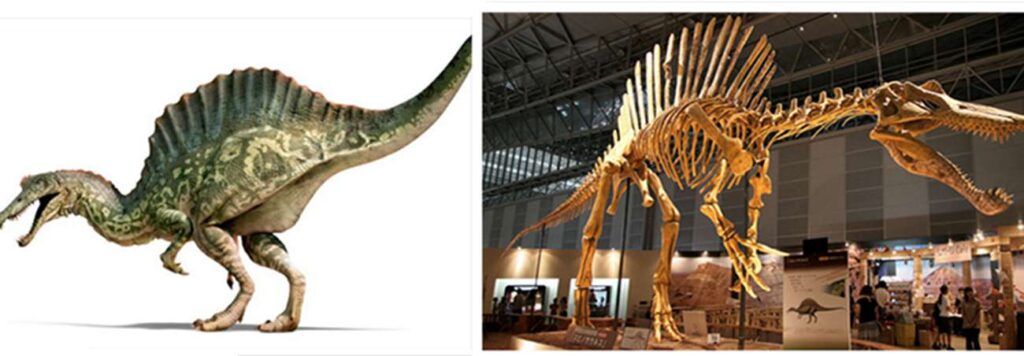
The Spinosaurus, recognized as the world’s first swimming dinosaur and the largest carnivorous dinosaur, possessed crocodile-like jaws and a sail of skin with long spines protruding from its back, making it one of the most powerful and most dangerous dinosaurs in existence.
This predator, which lived between 99-93.5 million years ago in Northern Africa, weighed approximately 10 tons and measured 4.3 to 7 meters in length. Its large jaws were used to catch fish from deep rivers, while its cruel set of claws terrorized smaller land-bound dinosaurs and even the gigantic crocodile Sarcosuchus.
The vertebrae of Spinosaurus were estimated to be twenty times larger than those of T-rex, giving it an immense advantage in size and strength. With these adaptations, Spinosaurus secured its place as one of the top predators to have ever roamed the Earth.
#2 Stegosaurus
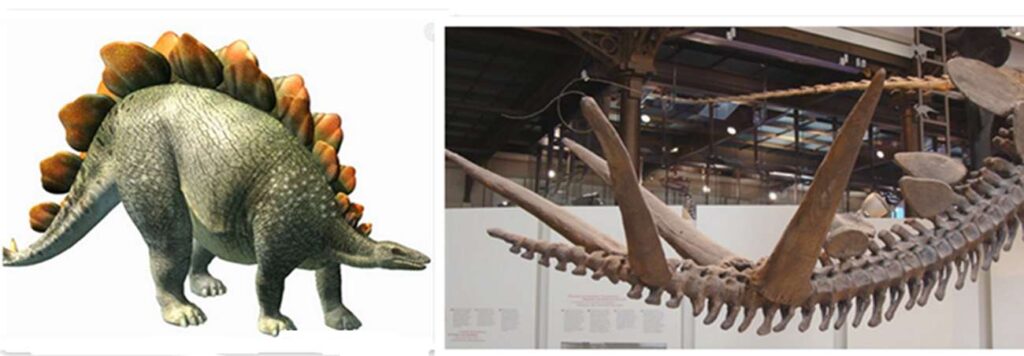
Despite its relatively small brain size, Stegosaurus is known for its unique body structure, which includes a tail tipped with spikes that it used for defense and intimidation. This herbivorous dinosaur belonged to the family Stegosauridae and lived approximately 155-150 million years ago. It measured about 6.5 to 9 meters in length and weighed around 3100 kilograms. The distinctive feature of Stegosaurus was its row of upright plates on its back, which were likely used for thermoregulatory functions rather than defense. These plates may have helped regulate the dinosaur’s body temperature by absorbing or dissipating heat.
Additionally, Stegosaurus had short forelimbs and long hind limbs, indicating that it was quadrupedal in nature. Its spiked tail was primarily used as a weapon against predators, allowing it to bash their skulls and scare away smaller creatures.
 | Name: Stegosaurus Temporal Range: 155-150 million years Kingdom: Animalia Phylum: Chordata Size: 6.5 to 9 m Mass: 3100 kg Family: Stegosauridae Discoverer: Othniel Charles Marsh Year of Discovery: 1877 |
#3 Velociraptor
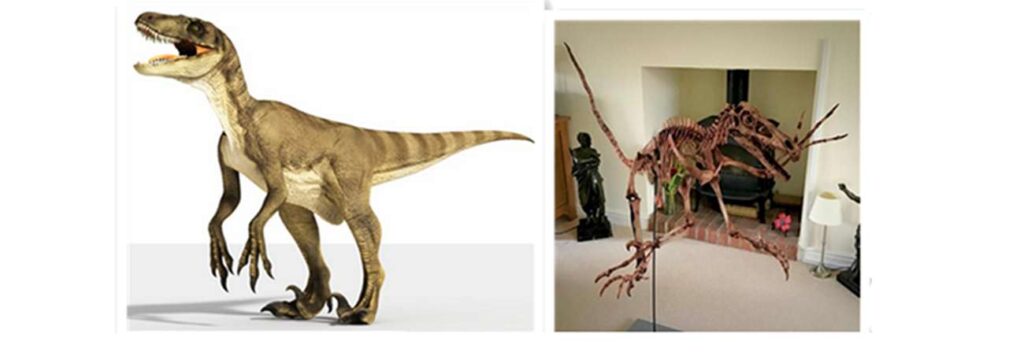
Velociraptor, known for its agility and intelligence, was a small theropod dinosaur that lived approximately 75-71 million years ago. With a size ranging from 0.5 to 2 meters and weighing around 15 kilograms, Velociraptor belonged to the family Dromaeosauridae.
Discovered by Henry Fairfield Osborn in 1924, this dinosaur has gained popularity through its portrayal in movies such as Jurassic Park.
Contrary to its depiction in films, Velociraptors were not as large or menacing. However, their true danger lay in their speed and cunning nature. Resembling birds more than reptiles, these predators possessed hook-like claws on each foot which they used to grasp their prey. Velociraptors were believed to hunt in packs, utilizing teamwork and communication to bring down larger targets.
While not the largest or most fearsome dinosaur of its time, Velociraptor’s combination of agility, intelligence, and formidable claws made it one of the deadliest predators during the Late Cretaceous period.
#4 Utahraptor
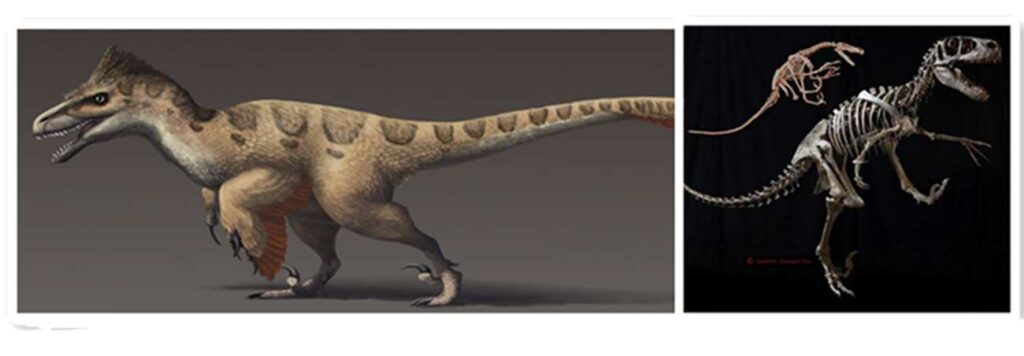
Utahraptor, known for its immense size and lethal hunting abilities, was a formidable predator during the Early Cretaceous period. Equipped with sharp claws measuring approximately 9 inches in length and razor-sharp teeth, the Utahraptor possessed the ability to quickly dispatch its prey. With a top sprinting speed and the capability to hunt in packs, this dinosaur was a highly efficient predator.
Its unique anatomical features included sickle-shaped claws on each hind foot and unusually thick leg bones that aided in driving its killing claw into its prey repeatedly. The body structure and gigantic size of the Utahraptor struck fear into other dinosaurs as well. To provide a visual representation of this fierce predator, consider the following table:
| Feature | Description |
|---|---|
| Size | 1.8 to 2 meters |
| Mass | 300 to 1000 kilograms |
| Family | Dromaeosauridae |
| Discoverer | Kirkland, Gaston & Burge (1993) |
Through an understanding of Utahraptor’s characteristics and adaptations, we can comprehend why it is regarded as one of the most dangerous dinosaurs that ever roamed the Earth during its time.
#5 Carcharodontosaurus
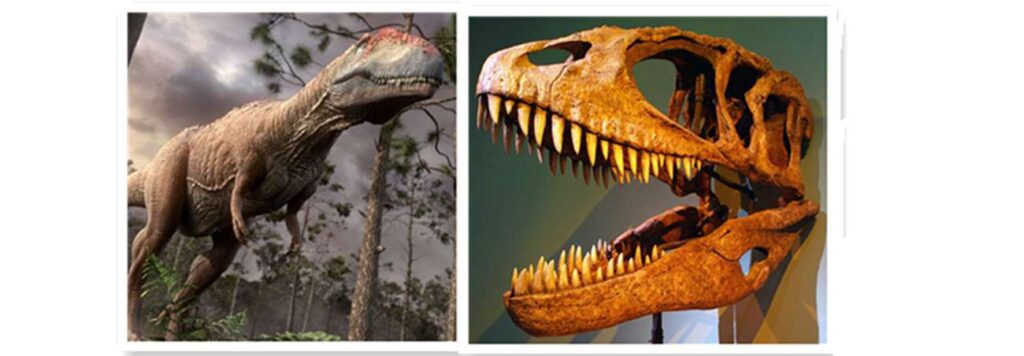
Carcharodontosaurus, a member of the Carcharodontosauridae family, is known for its formidable characteristics and unique adaptations that allowed it to be an efficient predator during the Late Cretaceous period.
With a length of 8 to 14 meters and a weight ranging from 6000 to 15000 kilograms, this dinosaur was one of the largest carnivorous dinosaurs of its time.
Its most notable feature was its shark-toothed jaw, equipped with 20-cm-long serrated teeth capable of slicing through flesh like switchblades.
Despite having a smaller brain size compared to some other dinosaurs, Carcharodontosaurus compensated with powerful legs that enabled it to reach speeds up to 32 km/h. This speed allowed it to outrun predators such as T-rex and facilitated successful hunts.
Overall, Carcharodontosaurus possessed the necessary traits making it one of the most dangerous dinosaurs during its existence in the prehistoric world.
#6 Tyrannosaurus rex
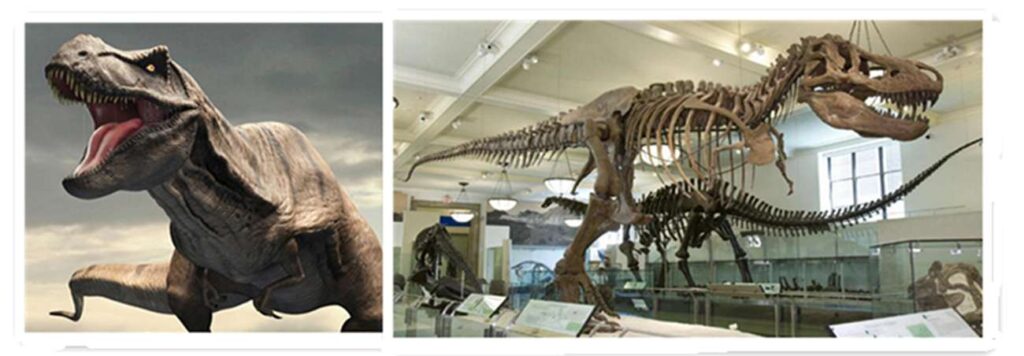
With its massive size, terrifying teeth, and lethal bite force, Tyrannosaurus rex was a formidable apex predator that struck fear into the hearts of all who encountered it. Belonging to the family Tyrannosauridae and discovered by Henry Fairfield Osborn in 1905, T-rex reigned supreme during the Late Cretaceous period, approximately 68-66 million years ago.
This dinosaur measured between 3.7 to 4.1 meters in height and weighed an astonishing 4500 to 14000 kilograms. Its name translates to ‘tyrant lizard king,’ emphasizing its status as the dominant creature among dinosaurs.
Tyrannosaurus rex possessed deadly bacteria in its saliva that ensured the prey’s demise even after escaping from its clutches. Its immense bite force of up to 18,000 pounds per square inch allowed it to deliver a fatal blow.
As an ultimate carnivore, T-rex would either hunt live prey or scavenge on already-dead carcasses. With these fierce characteristics and intelligence, Tyrannosaurus rex remains one of the most notorious and dangerous dinosaurs in history.
#7 Majungasaurus

Belonging to the family Abelisauridae, Majungasaurus is a unique dinosaur species with distinct skull features and a reputation as a cannibalistic predator. This dinosaur lived approximately 70-66 million years ago and was found in Madagascar, where its dental patterns were discovered on Majungasaurus bones.
Here are four intriguing facts about Majungasaurus:
1) Size and weight: Majungasaurus was estimated to be around 6 to 8 meters long and weighed about 1100 kilograms.
2) Cannibalistic behavior: Majungasaurus was known for its ruthless nature, even feeding on its own kind. However, it remains unclear whether these dinosaurs actively hunted live prey or scavenged from already-dead relatives.
3) Unique skull structure: The skull of Majungasaurus differed from other theropods, featuring specialized teeth that allowed it to firmly hold onto its prey while biting to death.
4) Discovery and classification: This dinosaur species was first discovered by Charles Depéret in 1896. It belongs to the phylum Chordata within the animal kingdom.
Majungasaurus stands out as an intriguing example of the most dangerous dinosaur and cannibalistic dinosaur with unique anatomical features.
#8 Mapusaurus

Mapusaurus, a formidable carnivorous predator, was estimated to be approximately 30 feet long and is believed to have hunted in coordinated packs, making it a force to be reckoned with in the prehistoric world. With its close resemblance to Giganotosaurus, Mapusaurus possessed narrow blade-like teeth that were ideal for slicing through prey before tearing it apart. This lethal dinosaur belonged to the family Carcharodontosauridae and existed during the Late Cretaceous period, around 97-93.5 million years ago.
Weighing an impressive 3,000 kg and measuring between 10-13 meters in length, Mapusaurus was truly a giant among dinosaurs. Its hunting strategy of pack coordination provided additional strength for extra lethality, allowing them to take down even the most powerful dinosaurs of their time. The discovery of this ferocious predator in 2006 by Coria & Currie has shed light on the remarkable diversity and adaptability of ancient carnivorous dinosaurs.
| Feature | Description |
|---|---|
| Temporal Range | 97-93.5 million years |
| Kingdom | Animalia |
| Phylum | Chordata |
| Size | 10 to 13 m |
| Mass | 3,000 kg |
Table: Key Features of Mapusaurus
#9 Allosaurus
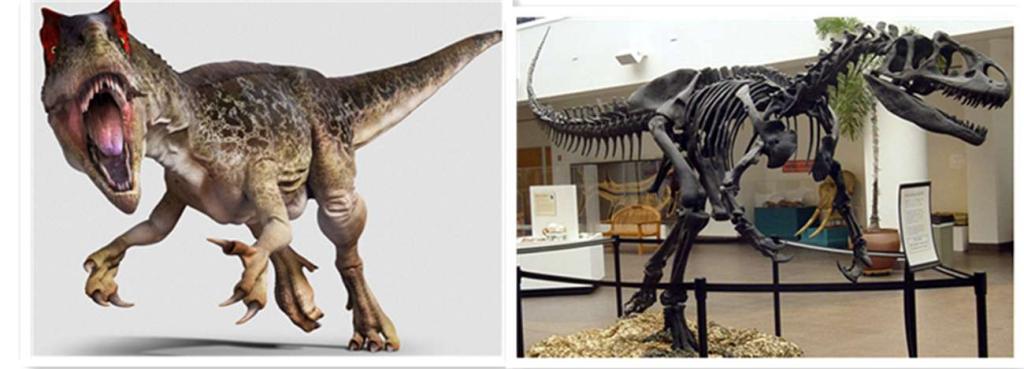
Allosaurus, a formidable predator of the Jurassic period, possessed sharp serrated teeth and powerful three-fingered hands tipped with massive talons, making it a fearsome carnivore capable of capturing its prey with precision.
This dinosaur, measuring between 5 to 12 meters in length and weighing between 1000 to 4000 kg, is considered one of the deadliest dinosaurs of its time. Its ability to take down prey twice its size, including larger than Tyrannosaurus rex, showcases its strength and ambition as a hunter.
Discovered by Othniel Charles Marsh in 1878, Allosaurus was part of the family Allosauridae and thrived approximately 155-145 million years ago.
Despite its hunting prowess, paleontologists believe that Allosaurus was not highly intelligent. In fact, evidence suggests that some individuals perished due to their own lack of caution while feeding on already trapped and struggling prey in Utah.
#10 Giganotosaurus
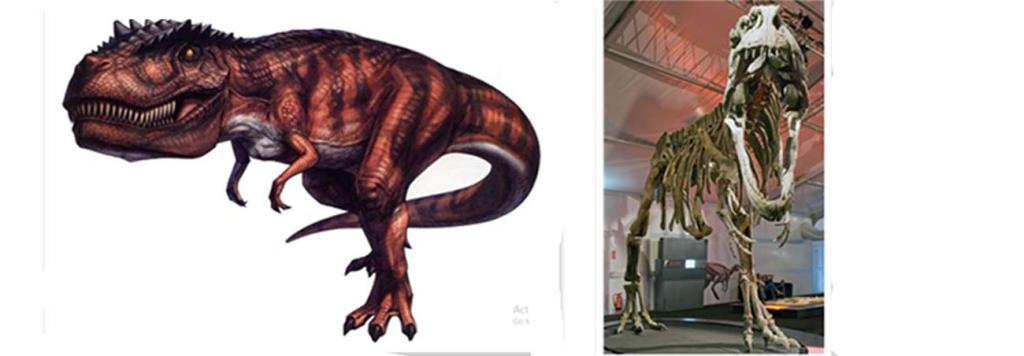
Giganotosaurus, a massive and formidable predator of the Late Cretaceous period, possessed an intimidating appearance and superior balance, allowing it to achieve remarkable speed and effectively bring down even fully-grown titanosaur adults.
This South American cousin of Carcharodontosaurus was one of the largest dinosaurs on Earth, measuring between 12 to 13 meters in length and weighing approximately 4200 to 14000 kilograms.
Its three-fingered hands were equipped with sharp claws that enabled it to grasp its prey securely.
With its powerful jaws filled with serrated teeth up to 8 inches long, Giganotosaurus could inflict devastating bites on its victims.
Additionally, its keen sense of smell helped it locate potential prey over long distances.
Overall, Giganotosaurus was a fearsome predator that reigned supreme during its time in the prehistoric world.
#11 Ankylosaurus
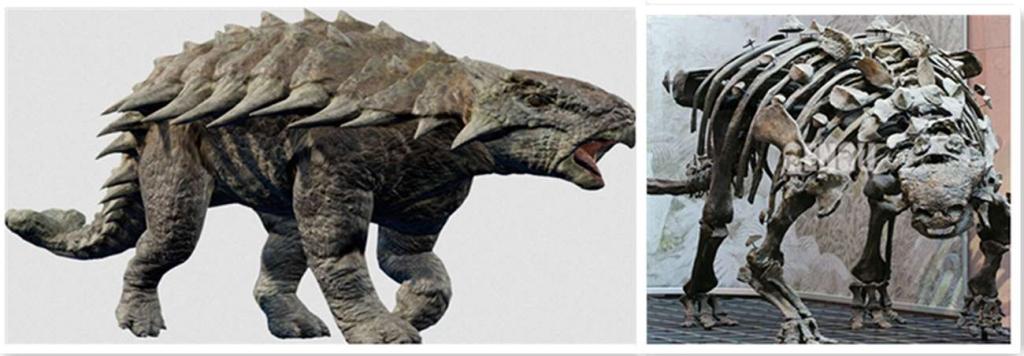
Ankylosaurus, with its heavily armored body and formidable tail, commanded respect and struck fear into the hearts of its adversaries.
This herbivorous dinosaur, discovered by Barnum Brown in 1908, lived during the Late Cretaceous period approximately 70-66 million years ago.
Measuring about 1.7 meters in height and weighing between 4800 to 8000 kilograms, Ankylosaurus was a force to be reckoned with.
Its most notable feature was its knobby hundred-pound tail, which served both defensive and offensive purposes.
With a swing of its massive tail, Ankylosaurus could generate enough force to crush bones and cause significant damage to even the mighty Tyrannosaurus rex.
Experts believe that this ability allowed Ankylosaurus to maintain its fierceness in the region and create havoc among predators.
#12 Saurophaganax
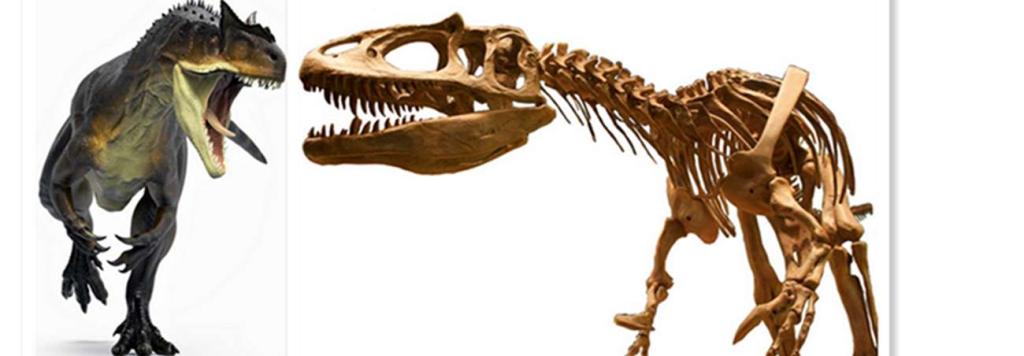
Saurophaganax, known as the lord of lizard-eaters, was an impressive Jurassic theropod and holds the title for being the longest terrestrial carnivorous species in history. With a size reaching 12-13 meters, Saurophaganax belonged to the Allosauridae family and resided in the Morrison Formation.
Its immense power allowed it to hunt any dinosaur within its vicinity, including large sauropods and heavily armored stegosaurs. However, Saurophaganax faced fierce competition for food from other formidable predators like Ceratosaurus, Acrocanthosaurus, and Edmark.
Despite this rivalry, Saurophaganax’s sheer size and intimidating appearance made it a dominant force in its ecosystem. Its ability to take down such formidable prey highlights its position as one of the most dangerous dinosaurs that roamed the Earth during the Jurassic period.
#13 Diplodocus
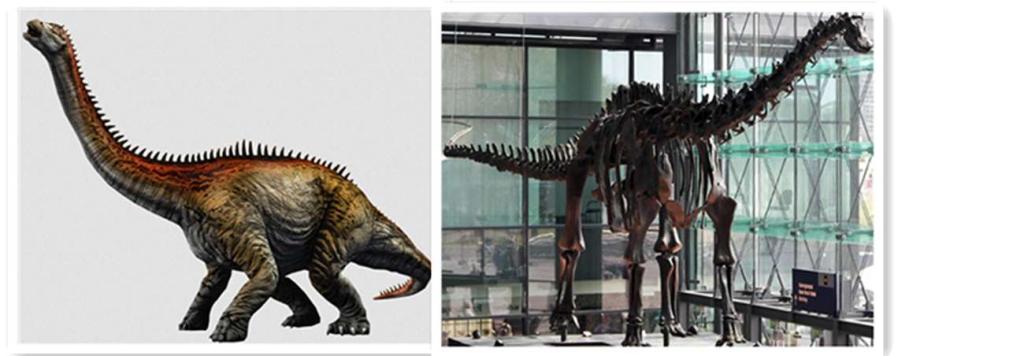
Diplodocus, a massive herbivorous dinosaur of the late Jurassic period, possessed unique physical attributes that allowed it to defend itself against potential threats and effectively navigate its environment. Despite its seemingly gentle nature, Diplodocus had a range of defensive mechanisms at its disposal. Its 20-foot-long tail served as a formidable weapon, capable of delivering devastating blows at hypersonic speeds. Furthermore, Diplodocus could use its hind foot to stomp on enemies, squishing them with great force.
Another fascinating feature was its ability to approach prey from gigantic heights due to its long neck and legs. This provided an advantage in foraging for food and potentially deterring predators. Overall, Diplodocus’ physical adaptations made it one of the most dangerous dinosaur despite being an herbivore.
| Physical Attribute | Function | Advantage |
|---|---|---|
| 20-foot-long tail | Weapon | Delivered powerful blows at hypersonic speeds |
| Hind foot | Stomping mechanism | Squished enemies with significant force |
| Long neck and legs | Height advantage | Allowed for effective foraging and predator deterrence |
This table highlights the key physical attributes of Diplodocus and their respective functions and advantages in defending against threats.
#14 Deinonychus
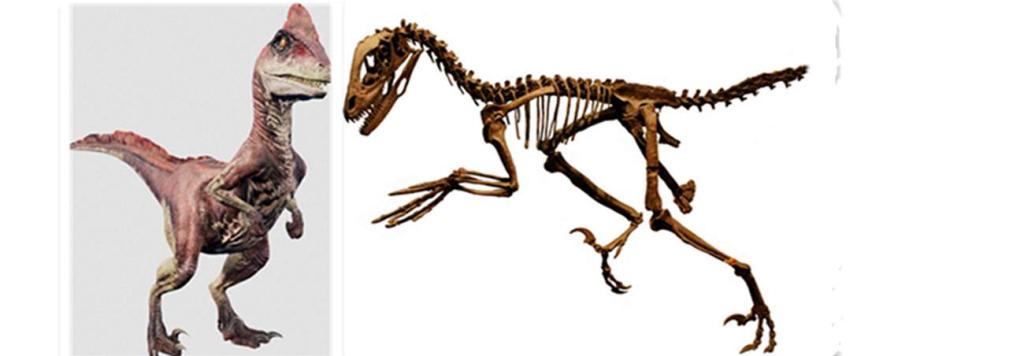
The discovery of Deinonychus provided new insights into the physical attributes and hunting strategies of smaller theropod dinosaurs during the Cretaceous period.
With an estimated size range of 3.4 meters in length and a mass of 73 to 100 kg, Deinonychus was a formidable predator.
It possessed interlocking vertebrae that allowed it to maintain balance while running, despite its large size compared to Velociraptor.
Its jaw, hands, and retractable toe-claws were equipped for disemboweling prey, making it a highly efficient hunter.
The discovery of Deinonychus challenged the previous perception that dinosaurs were slow and lumbering creatures due to their size.
Instead, it revealed that some dinosaurs were quick-witted pack hunters capable of fast pursuit and deadly attacks on their prey.
This knowledge deepens our understanding of dinosaur behavior during the Cretaceous period.
#15 Troodon
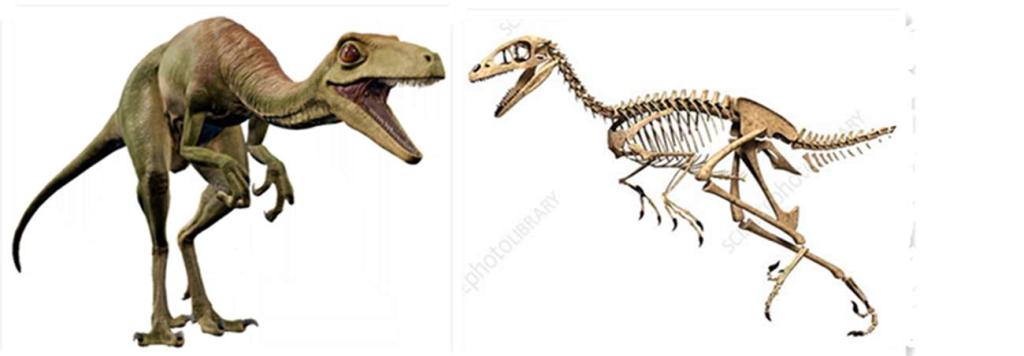
Troodon, a small and agile dinosaur with an advanced neurological structure, possessed the ability to hunt nocturnally and bring down larger prey through its superior vision and intelligence.
This 1.3-meter-tall and 40-kg creature had a brain-to-body-weight ratio that allowed for efficient brain functioning.
Troodon’s body structure and composition enabled it to run with greater speed and agility, making it a formidable predator.
Its huge orb-like eyes provided enhanced low-light vision, allowing for successful hunting in dark conditions.
Additionally, Troodon’s nascent signs of folding in the brain made it the most neurologically advanced specimen known.
With their intelligence and keen senses, groups of sharp-minded and agile Troodons could potentially take down even the most powerful dinosaurs.
Overall, Troodon was a dangerous dinosaur due to its combination of intelligence, agility, and adaptability to different lighting conditions during hunts.
#16 Coelophysis
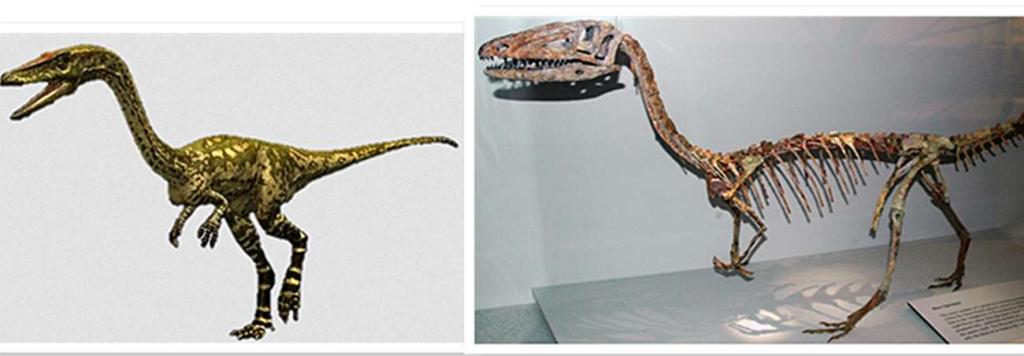
Coelophysis, a light-weight and agile dinosaur with blade-like cutting teeth, used its small size to its advantage by hunting in organized groups and strategically attacking prey. Weighing only around 44 pounds, Coelophysis relied on intelligence rather than physical strength to overcome its size limitations. They exhibited remarkable coordination and planning, enabling them to achieve their objectives swiftly and efficiently. Additionally, they exploited their diminutive stature by concealing themselves in small areas, launching surprise attacks at opportune moments.
To further comprehend the unique characteristics of Coelophysis compared to other dinosaurs, a comparison table is presented below:
| Coelophysis | Troodon | |
|---|---|---|
| Temporal Range | 216-196 million years | 77-75 million years |
| Size | 2 m | Up to 3 m |
| Mass | 18 to 23 kg | Approximately 50 kg |
| Family | Coelophysidae | Troodontidae |
Coelophysis’ adaptability and strategic hunting techniques exemplify the significance of intelligence in survival strategies. Despite its relatively small size, this dinosaur utilized teamwork and cunning tactics to secure food resources efficiently.
#17 Carnotaurus
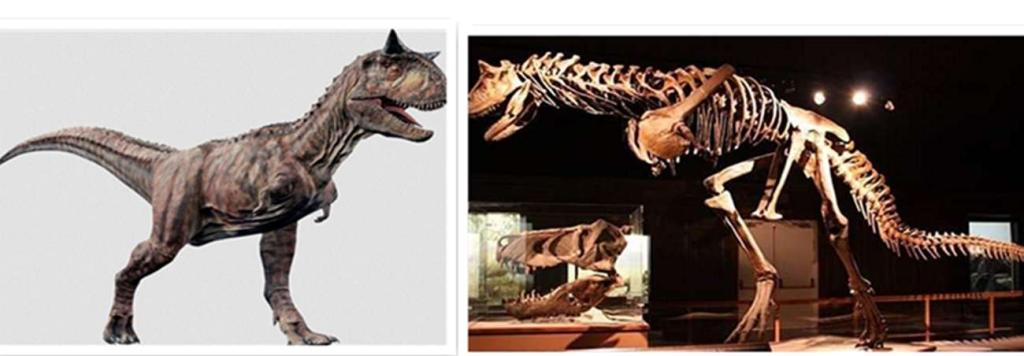
In the late Cretaceous period, Carnotaurus roamed the land as an apex predator, exhibiting unique adaptations and hunting strategies. Belonging to the Abelisauridae family, this dinosaur stood at around 8 to 9 meters in length and weighed between 1000 to 3000 kilograms.
Its most distinctive feature was its two horns on its head, which were used as hunting weapons to injure or kill small prey. Carnotaurus had smaller arms compared to other dinosaurs like the T-Rex but compensated for this with its powerful neck muscles that it used in hunting and fighting conspecifics. Evidence suggests that Carnotaurus engaged in combat with head blows or by using their horns as shock absorbers.
Despite having less developed hearing and sight, Carnotaurus possessed a keen sense of smell along with powerful muscles that allowed it to run fast without losing balance. This made it a formidable predator capable of taking down even large prey.
In conclusion, Carnotaurus was a highly most dangerous dinosaur due to its physical adaptations and hunting prowess during the late Cretaceous period.
#18 Tarbosaurus
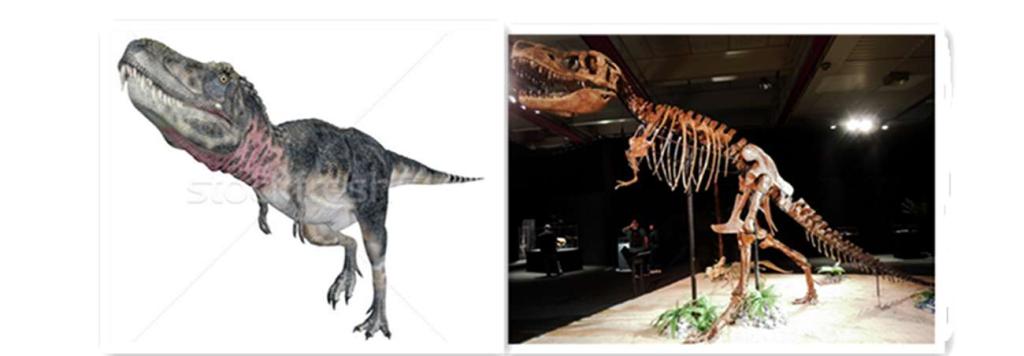
Tarbosaurus, a member of the Tyrannosauridae family, possessed unique physical adaptations and hunting strategies that made it a formidable predator in the late Jurassic period.
With a size ranging from 10 to 12 meters and weighing between 4000 to 5000 kilograms, Tarbosaurus was one of the largest carnivorous dinosaurs.
Its most distinct feature was its locking mechanism in the lower jaw, which allowed it to firmly grasp its prey. Equipped with 60 large teeth, Tarbosaurus had the ability to deliver powerful bites to immobilize its victims.
Additionally, Tarbosaurus was known for its crepuscular or nocturnal hunting habits, making it an efficient predator during low-light conditions.
This dinosaur’s strength and speed enabled it to hunt down large dinosaurs in its ecosystem.
The discovery of Tarbosaurus in 1955 by Maleev has added this species to the list of deadliest dinosaurs due to its exceptional predatory abilities.
#19 Megaraptor
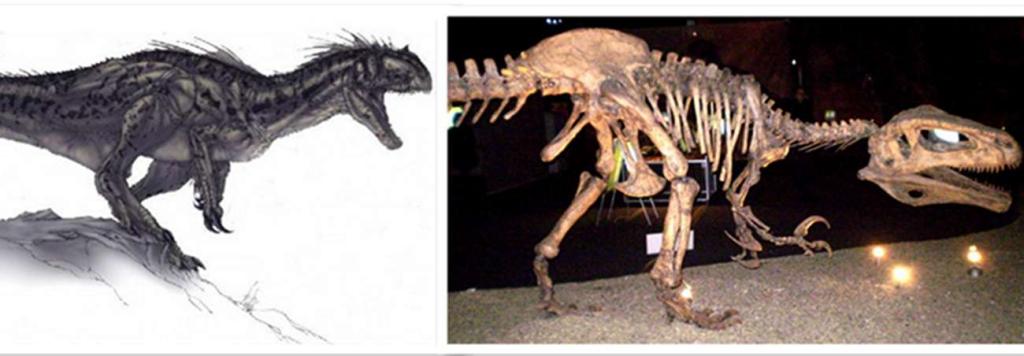
Megaraptor, a megaraptorid dinosaur discovered by Fernando Novas in 1998, possessed unique adaptations and physical characteristics that allowed it to be a successful predator during the Late Cretaceous period. Its most distinctive feature was its single sickle-shaped foot claw, which measured around 30 centimeters in length. This formidable weapon enabled Megaraptor to take down even large prey such as dilophosaurus.
Additionally, its unusually elongated hands and claws provided excellent tools for attacking enemies and capturing prey.
The dinosaur’s large size, approximately 26 feet long and weighing over 200 pounds, gave it an advantage in both offense and defense. With its heavyweight body structure, Megaraptor had strong defensive capabilities that made it a fearsome presence in its environment.
These adaptations combined to make Megaraptor one of the most dangerous dinosaurs of its time.
#20 Acrocanthosaurus
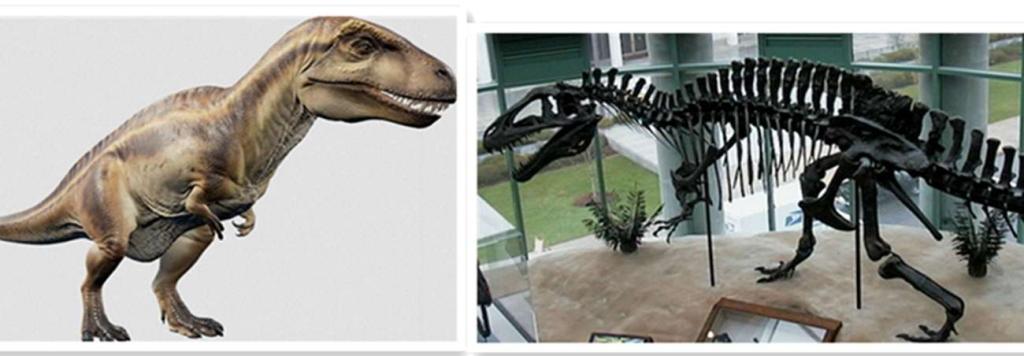
Moving on from the previous subtopic of Megaraptor, we now turn our attention to Acrocanthosaurus.
This apex predator lived approximately 116-110 million years ago and belonged to the family Carcharodontosauridae.
Measuring an average length of 11.5 meters and weighing between 5700 to 6200 kg, Acrocanthosaurus was a formidable creature.
Its distinguishing feature was its high neural spines on its vertebrae, supported by a ridge of muscle along its back, neck, and hips.
Unlike some other dinosaurs, Acrocanthosaurus had limited mobility in its forelimbs but compensated for this with its powerful jaws.
It would seize its prey using its mouth and then forcefully retract its heavily muscled forelimbs to prevent escape.
Large gashes were inflicted upon the prey using the predator’s sharp claws.
Academic research has provided us with valuable insights into this fascinating dinosaur’s physical characteristics and hunting strategies, shedding light on the life of one of history’s most dangerous dinosaur creatures.
Frequently Asked Questions
How did the Spinosaurus get its name?
The name “Spinosaurus” was derived from its most distinctive feature, the tall spines on its back. These spines were likely used for various purposes such as display, thermoregulation, or possibly even in combat with other dinosaurs.
What were the main characteristics of the Stegosaurus?
The Stegosaurus, a herbivorous dinosaur from the Late Jurassic period, possessed distinct characteristics that made it an intriguing subject of study. These included its large size, unique plate-like back armor, spiked tail, and small brain relative to its body size.
How did the Velociraptor hunt its prey?
The velociraptor hunted its prey by using its sharp claws and agile body to ambush and overpower its victims. It is believed that they hunted in packs, working together to bring down larger prey.
What is the significance of the Utahraptor in the study of dinosaurs?
The Utahraptor is significant in the study of dinosaurs due to its size and predatory behavior. With a length of up to 23 feet and sharp, curved claws measuring 9 inches long, it was an apex predator during the Early Cretaceous period.
How does the Carcharodontosaurus compare to the Tyrannosaurus rex in terms of size and strength?
The Carcharodontosaurus and Tyrannosaurus rex were both large theropod dinosaurs. While the Carcharodontosaurus may have been slightly larger in size, the Tyrannosaurus rex is believed to have had a stronger bite force. Further research is needed for a more accurate comparison.
Conclusion
Spinosaurus, Stegosaurus, Velociraptor, Utahraptor, Carcharodontosaurus, Carnotaurus, Tarbosaurus, Megaraptor, and Acrocanthosaurus are some of the most dangerous dinosaurs known to mankind. With their sharp teeth and powerful jaws, these prehistoric creatures ruled the ancient world.
The Spinosaurus stood out for its enormous size and sail-like structure on its back. The Utahraptor was a fast and agile predator with deadly claws. The Carcharodontosaurus had serrated teeth similar to those of a shark. These formidable beasts showcase the ferocity and diversity of the dinosaur kingdom.
In conclusion, the study of these most dangerous dinosaurs provides valuable insights into the intricate world of prehistoric predators. Their various adaptations and unique characteristics demonstrate their ability to survive and thrive in an ancient ecosystem filled with challenges. Understanding these ancient creatures helps us appreciate the complexity of life on Earth millions of years ago. Through meticulous research and analysis, scientists continue to unravel the mysteries surrounding these awe-inspiring creatures from a bygone era.

















